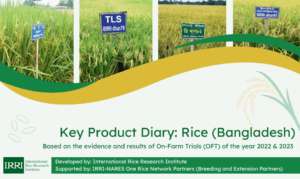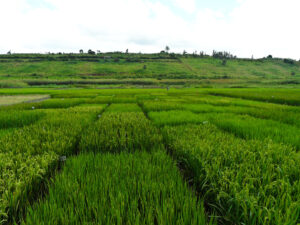by Erythrina Erythrina, Susilawati Susilawati, Slameto Slameto, Made Delly Resiani, Forita Dyah Arianti, Jumakir Jumakir, Anis Fahri, Andy Bhermana, Asmanur Jannah, and Hasil Sembiring
The goals of smallholders in rainfed areas are generally to reduce risks, generate income, and achieve food security. These goals, to some extent, could be achieved by practicing intercropping. Farmers could more effectively utilize their land area and time and thus increase their income and production efficiency by practicing intercropping, especially if adopting maize–soybean and rice–soybean intercropping systems.
Many diverse cropping systems have increased food production and farmers’ incomes in Africa, India, and China. One of these systems is intercropping, i.e., growing two or more crop species simultaneously in the same field during a growing season.
Efficient utilization of land resources, where scarcity of land compels farmers to grow many crops on a small piece of land, is one of the rationales for intercropping in traditional farming systems. Recent research has raised several concerns about the future sustainability of rice–maize cropping systems. Yield growth rates have slowed and reached a plateau in some significant rice-producing regions including Indonesia, representing a potential issue in meeting future rice demand, which is expected to increase.
Due to its limited land for food production and high population, Indonesia is testing various methods in an attempt to increase the production of food crops, especially rice, maize, and soybean. Maize and soybean are the second and third most important strategic commodities after rice. Rice–maize intercropping systems are crucial in ensuring food security. Rice–soybean or maize–soybean combinations provide food and nutritional security to smallholders of rainfed lands. Thus, they may be considered suitable options for small farmers’ food and livelihood security.
Out of around 20.3 million food crop farmer households in 2018, intercropping systems are applied in approximately 12.5% of upland rice households, 15.8% of maize households, and 23.2% of soybean households.
Intercropping has some advantages for small farmers whose farm operations are labor-intensive and who use simple tools for cultivation on smallholding. The potential area of rainfed with a wet climate available for food crop development in Indonesia is 2.7 million ha, and such areas are primarily found in Sumatra, Java, Kalimantan, and Papua.
Climatologically, they are characterized by having >1500 mm year−1 rainfall and several wet months, i.e., >7 months with rainfall of >100 mm month−1. Due to a longer growing season, where multiple cropping is feasible, the capture of resources and yield are often improved through facilitation and niche differentiation in time and space.
Due to a longer growing season, the potential advantage of combining cereal–legume intercropping provides greater scope for minimizing the adverse impact of moisture and nutrient stress and improving system productivity. In terms of the time component crops take in the intercrop, cereal–legume intercropping is shorter when compared to the growing season.
Except for the soils in West Nusa Tenggara, East Nusa Tenggara, and East Timor, where the climate is relatively dry, the lands of the other areas have mainly developed under humid tropical conditions from acid sedimentary rocks. In general, Ultisols and Oxisols are dominant.
Oxisols and Ultisols are highly weathered, low-activity, freely draining soils with low content of weatherable minerals, low-nutrient retention, and high leaching pressure. Therefore, upland soils are acidic with high aluminum (Al) saturation, low phosphorus, and low base saturation. Acidity and Al toxicity are the most critical agronomic problems.
Small family farms characterize farming in China and Southeast Asia; they are usually less than 1 ha in size, and farm income is an essential element of livelihood in these regions. To accelerate the adoption and dissemination of intercropping patterns, farmers must consider several factors, such as the planting density of the two mixed crops, the adaptation of high-yielding cultivars, increasing production costs, and yields and profits.
Few studies on rice–maize, rice–soybean, or maize–soybean intercropping have evaluated the increase in farmer land productivity and profitability, especially in rainfed areas of Southeast Asia. It is increasingly rare to find intercropping studies in which farmers are directly involved, such as participatory demonstration plots related to labor productivity and cost productivity in actual conditions.
Different indices are used to assess crop yields, the competition intensity of the component crops, and the economic efficiency of intercropping practices compared with monocropping practices of sole crops.
In this research study, we used the gross margin and profit analysis under farmer participatory demonstration plots to assess the intercropping system’s financial viability in addition to those indices. Therefore, we hypothesize that to increase the profit margin, intercropping practices may reduce the cost per unit output and increase labor productivity compared to monoculture practices.
Here, we focus on rice–maize, rice–soybean, and maize–soybean intercropping systems as a case study. We aimed to assess different intercropping practices of rice–maize, rice–soybean, or maize–soybean compared to monocropping practices of rice, maize, or soybean as sole crops based on yield advantage and economic performance in the rainfed areas of western Indonesia with wet climate.
Based on different indices used to assess crop yields, competition intensity, and economic efficiency, our results demonstrate that intercropping practices are more beneficial than monocropping practices in the compared systems. The results for intercropping indicate that maize–soybean provides the highest percentage of net return gains (62.5%) followed by rice–soybean (57.3%), with the lowest for rice–maize (47.1%).
The intercropping advantage assessment supports the estimation of economic indices. In using the land equivalent ratio (LER) to describe the magnitude of the yield increase for intercropping practices (IPs) over monocropping practices (MPs), yield advantages of 63%, 54%, and 44% were recorded for maize–soybean, rice–soybean, and rice–maize, respectively.
Area time equivalent ratio values were 30%, 30%, and 32% higher for the same IP compared with sole cropping. The land use efficiency values also increased by 46%, 43%, and 38%, respectively, in comparison to sole cropping. Intercropping increased the land equivalent coefficient of maize–soybean, rice–soybean, and rice–maize by 0.66, 0.60, and 0.50, respectively. The percentage yield difference showed a similar trend to LER in all intercropping systems.
The goals of smallholders in rainfed areas are generally to reduce risks, generate income, and achieve food security. These goals, to some extent, could be achieved by practicing intercropping. Given the above data and conclusions, farmers could more effectively utilize their land area and time and thus increase their income and production efficiency by practicing intercropping, especially if adopting maize–soybean and rice–soybean intercropping systems.
Read the study:
Erythrina E, Susilawati S, Slameto S, Resiani NMD, Arianti FD, Jumakir J, Fahri A, Bhermana A, Jannah A, Sembiring H. (2022) Yield advantage and economic performance of rice–maize, tice–soybean, and maize–soybean intercropping in rainfed areas of Western Indonesia with a wet climate. Agronomy. 12(10):2326.






